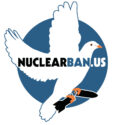No one country wants to give up all their existing nuclear weapons without knowing that the others will also give up theirs. This is what has held back the process of getting rid of these weapons for the last 73 years! We have to move beyond that kind of thinking. Someone has to take the first step. Since these weapons do not protect us and can never be used without catastrophic consequences for the whole planet, there is no logical reason why the US cannot, or should not, take the lead on this.
The Treaty Compliance Campaign is calling on the United States to take that first step and sign the Treaty. However, that does not mean that we expect the US to ‘unilaterally’ eliminate its nuclear arsenal, regardless of what the other 8 nuclear weapons nations do. Instead, we are calling for the United States to go through a 3-Step Process in order to reach the point, at step 3, where it is able to ratify the Treaty, knowing that the other nuclear armed nations are going down the same path to eliminate all nuclear weapons from the face of the earth. This is not as difficult or complicated as people may think. It does not require a whole new drawn-out process to negotiate an entirely new treaty. It requires only that the US takes the lead and waits to see how Russia and the other nuclear armed nations respond.
Step #1: DECLARING support for the Treaty, by signing it, would be a powerful signal to other nuclear armed nations that the United States is serious about eliminating all nuclear weapons, globally. Someone has to make the first move. We call on the President of the United States to make that move. Signing a treaty is a statement of political will. It is no more than that. There is no legal commitment until the treaty is ratified. But it is the political will that is so importantly needed to remove the logjam that has stymied the process of nuclear disarmament for all these years. It should be accompanied by an invitation to Russia and the other nuclear armed nations to do likewise and sign the Treaty. And it would also be accompanied by the setting up of a Presidential Commission to investigate how the US would go about actually implementing the Nuclear Ban Treaty and the implications of doing so. Such a Commission would be comprised of distinguished and competent people from different walks of life, who would be given the task of overseeing the rest of the process leading to the US actually ratifying the Treaty in step 3.
Step #2: DISCONNECTING the US from its dependency on nuclear weapons will require looking in detail at the industrial infrastructure that supports these weapons and the jobs that will need to be diverted to other work. This means holding public hearings, gathering evidence and taking testimony in order to determine the full extent of what will be required to eliminate US nuclear weapons while at the same time ensuring that the country remains secure from external threats and that technologies, industries and jobs currently allocated to nuclear weapons can be re-directed to more socially-useful tasks, such as addressing climate change. During this phase of the process, negotiations with the other nuclear armed nations would also be taking place to coordinate the disarmament process as it proceeds. The end product of this step is a time-bound Treaty Compliance Plan for the verifiable and irreversible elimination of the US nuclear weapons program. This lays out exactly how and when US nuclear weapons would be eliminated, as well as how that process will be tied to what happens in the other nuclear armed nations.
Step #3: DECIDING to actually implement the Treaty means going through the process of ratification (by the Senate). This requires National Legislation that legally commits the United States to implementing the Treaty Compliance Plan within a specified period of time. Before this point is reached, the US would know whether other nuclear armed nations were ready to ratify and implement the Treaty as well. The US would know what those other time-bound treaty compliance plans looked like. And the US would know how the different plans interacted with each other to ensure no one country feels they are left at an unfair advantage in relation to the other. This might mean, for instance, that the US Compliance Plan requires the first US weapon to be dismantled by, let’s say January 1st, 2020. The Russian Compliance Plan would then require their first weapon to be dismantled by, say February 1st, 2020. And the US Compliance Plan would then require the second US weapon to be dismantled by March 1st, 2020, assuming the first Russian weapon had been dismantled by then, and so on. This is a very standard way of implementing a peace agreement. It’s easy and it works. Once the treaty is ratified and enters into force for the US, implementation would begin, in conjunction with Russia and the other nuclear armed nations, of a set of legally-binding, time-bound plans for the verified and irreversible elimination of all nuclear weapons.







Excellent and cogent overview, Tim. This will help me to construct my case when addressing our state-wide conference of church’s (United Church of Christ-or UCC), first in Mass. and then, hopefully, Connecticut and Rhode Island.
Great news: this past Sunday, my local church, First Churches, N’ton, unanimously voted to adopt the Resolution, similar to the City’s. Now three UCC churches are “engaged” in advocacy and compliance. This enables me to advance the cause among the wider ranks!
All the best to Vicki,
-ever thankful, Peter